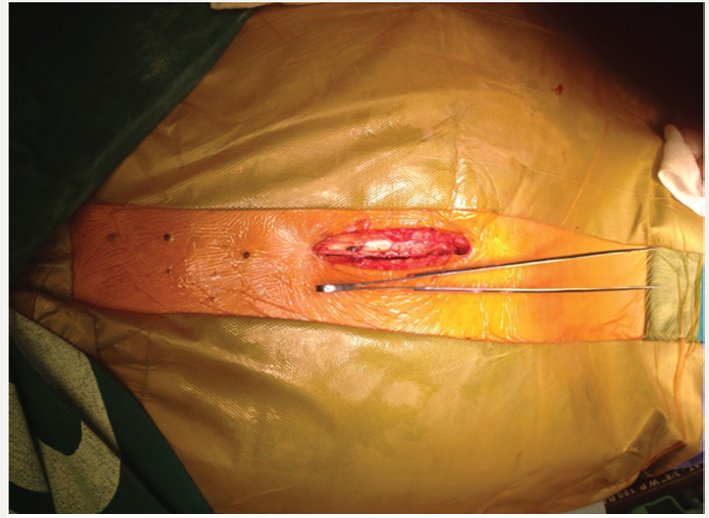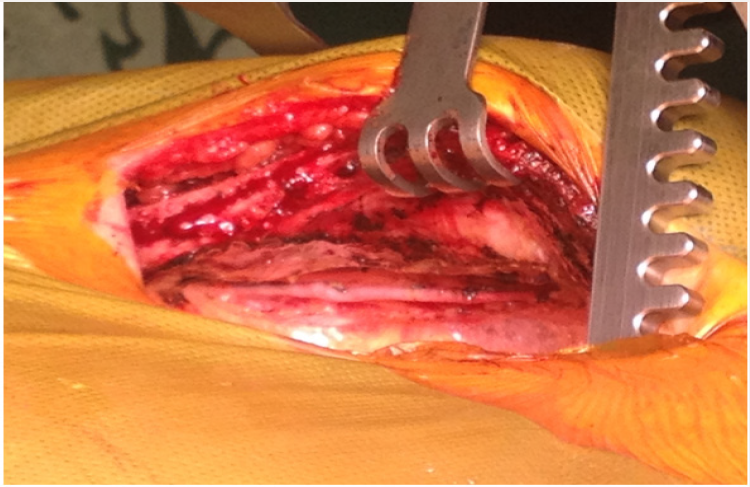
Lupine Publishers Group
Lupine Publishers
Menu
ISSN: 2643-6760
Mini Review(ISSN: 2643-6760) 
Mini OPCAB Coronary Artery Bypass Surgery Plus Medical Treatment: An Option for High Risk Coronary Patients Volume 1 - Issue 2
Federico Benetti* and Natalia Scialacomo
- Cardiac Surgery Department, Benetti Foundation, Argentina
Received: May 15, 2018; Published: May 18, 2018
Corresponding author: Federico Benetti, Cardiac Surgery Department, Benetti Foundation, Alem 1846, Rosario Argentina Zip-2000, Argentina
DOI: 10.32474/SCSOAJ.2018.01.000106
Abstract
MINI OPCAB surgery (Xiphoid Approach) is a surgical technique in which the left internal mammary artery is bypassed to the Anterior Descending Artery (ADA) by a medial inferior sternotomy Fourteen high risk patients with multiple coronary disease with a preoperative logistic Euroscore of 10.86 were operated and follow up with medical treatment and strictly control of risks factors MACE at 80 months was 0% and Survival at 7 years 82% (KM) Although is an alternative the combination of Mini OPCAB operation plus medical treatment in high risk. Patients with multiple vessels coronary disease, more experience is needed to confirm this initials results. Statistical analysis applied the student test (SPSS program), with p<0.05 were considered significant
Keywords: Mini Opcab; Minimally Invasive Coronary Surgery; Coronary High Risk Patients
Introduction
In high-risk patients with multiple vessel disease who are not candidates for conventional surgery with extracorporeal circulation or for percutaneous procedures as a single treatment, the alternative of left mammary artery to left internal descending artery bypass graft surgery without extracorporeal circulation offers advantages over medical treatment [1,2].
a) The MIDCAB operation
b) Is effective to treat high risk patients with multiple vessel disease. Greater long-term follow-up is necessary to clarify the indications and validate the procedure for this type of patients.
c) MINI OPCAB surgery (Xiphoid Approach) is a surgical technique in which the left internal mammary artery is bypassed to the Anterior Descending Artery (ADA) by a medial inferior sternotomy approach in the 3rd or 4th intercostal space, leaving intact the sternal manubrium (Figures 1 & 2). Long-term results have already been published, reaching 82% survival at 12 years (Kaplan-Meier).
d) This presentation describes the experience with this surgical technique in our institution [3,4].
Materials and Methods
Fourteen high risk patients with multiple vessel coronary artery disease with mean age of 71.07 years (±9.051, 95% CI), 21% women and mean preoperative Logistic EuroSCORE of 10.68 (±5.407, 95% CI), were operated-on in the last 7 years, followed up in our institution with strict medical treatment and control of risk factors.
Result
Operative mortality in this series was 0%, the incidence of perioperative infarction was 0%, the average duration of surgery was 2 hours and 20 minutes; 10 (71%) patients were extubated in the operating room and average hospital stay was 2 days and 11 hours. Following the intervention, one patient received a stent in the right coronary artery and another in the circumflex artery for presenting large arteries with severe lesions. In this group of patients, major adverse cardiovascular events were 0% at 80 months. Survival rate was 82% at 7 years (Kaplan-Meier); an 85-year-old woman died 5 years after surgery due to stroke.
Conclusion
The combination of a MINI-OPCAB surgery for bypass of the left internal mammary artery to the left anterior descending artery [5,6] together with an adequate medical treatment and a hybrid treatment when the right coronary artery or circumflex artery are of high caliber, is a viable option for elderly and high-risk patients. More experience is needed to confirm these initial results.
References
- Prestipino F, Spadaccio C, Nenna A, Sutherland FW, Beattie GW, et al. (2016) Off-pump coronary artery bypass grafting versus optimal medical therapy alone: effectiveness of incomplete revascularization in high risk patients. J Geriatr Cardiol 13(1): 23-30.
- Benetti FJ (1999) Method for coronary artery bypass. United States Patent N 5,888,247, USA.
- Izzat MB, Yim AP (1997) Minimally invasive LAD revascularisation in high-risk patients with three-vessel coronary artery disease. Int J Cardiol 62(1): S101-S104.
- Benetti FJ (2010) MINI-off-pump coronary artery bypass graft: longterm results. Future Cardiol 6(6): 791-795.
- Kowalewski M, Suwalski P, Pawliszak W, Benetti F, Raffa GM, et al. (2016) Risk of stroke with “no-touch”- As compared to conventional off-pump coronary artery bypass grafting. An updated meta-analysis of observational studies. Int J Cardiol 222: 769- 771.
- Zhao DF, Edelman JJ, Seco M, Bannon PG, Wilson MK, et al. (2017) Coronary artery bypass grafting with and without manipulation of the ascending aorta: A Network Meta-Analysis. J Am Coll Cardiol 69(8): 924- 936.

Top Editors
-

Mark E Smith
Bio chemistry
University of Texas Medical Branch, USA -

Lawrence A Presley
Department of Criminal Justice
Liberty University, USA -

Thomas W Miller
Department of Psychiatry
University of Kentucky, USA -

Gjumrakch Aliev
Department of Medicine
Gally International Biomedical Research & Consulting LLC, USA -

Christopher Bryant
Department of Urbanisation and Agricultural
Montreal university, USA -

Robert William Frare
Oral & Maxillofacial Pathology
New York University, USA -

Rudolph Modesto Navari
Gastroenterology and Hepatology
University of Alabama, UK -

Andrew Hague
Department of Medicine
Universities of Bradford, UK -

George Gregory Buttigieg
Maltese College of Obstetrics and Gynaecology, Europe -

Chen-Hsiung Yeh
Oncology
Circulogene Theranostics, England -
.png)
Emilio Bucio-Carrillo
Radiation Chemistry
National University of Mexico, USA -
.jpg)
Casey J Grenier
Analytical Chemistry
Wentworth Institute of Technology, USA -
Hany Atalah
Minimally Invasive Surgery
Mercer University school of Medicine, USA -

Abu-Hussein Muhamad
Pediatric Dentistry
University of Athens , Greece

The annual scholar awards from Lupine Publishers honor a selected number Read More...













